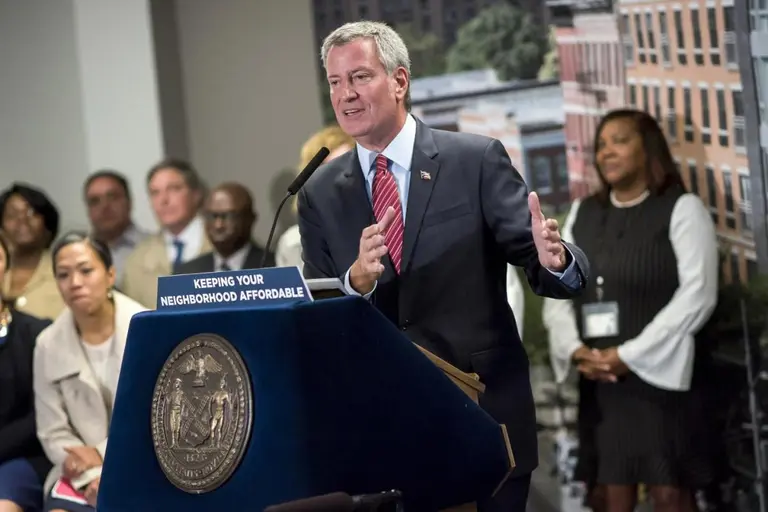New migrant shelter in Clinton Hill could serve at least 2,000 people

Streetview of 47 Hall Street. © 2023 Google
New York City is opening two more emergency shelters to accommodate the thousands of migrants that continue to arrive in the five boroughs, one of which is set to become the largest dormitory-style shelter in the city’s history. Mayor Eric Adams on Tuesday announced the opening of two more humanitarian relief shelters, one at an existing respite center at 47 Hall Street in Brooklyn, which adds additional space to serve roughly 1,400 more migrant adults, and another at the Crowne Plaza JFK Airport New York hotel in Queens, which will serve more than 330 families with children seeking asylum.
Located in a block-sized facility near the Brooklyn Navy Yard in Clinton Hill, Brooklyn’s newest emergency shelter is at a development called The Hall. The site is projected to house upwards of 2,000 people with its new expansion, according to The City. Once the new shelter reaches capacity, only the Row Hotel in Midtown will house more occupants, with hundreds of families with children spread out through the hotel’s 1,000 rooms.
The Hall complex is owned by RXR Realty, which in 2018 announced plans to renovate the property and transform it into office space. However, when the renovation was completed in 2021, the Covid-19 pandemic completely changed work life, leading to a surge in office vacancies as many workers chose to work from home, according to The City. Neither RXR nor the city has said how much the city is paying to rent the complex.
The second shelter, located at a hotel in close proximity to JFK Airport in Jamaica, will be converted from a temporary respite center to a full-fledged humanitarian relief shelter equipped to host asylum seekers for long-term stays. The newly upgraded facility should be able to house more than 330 asylum-seeking families.
This is the second shelter set up in the area around JFK Airport. In June, the city converted a warehouse within the airport’s compound into a shelter, bringing in 500 cots and several trailers with showers and bathrooms to accommodate asylum seekers. Known as Building 197, the warehouse was originally used as an overflow facility for the United States Postal Service.
“New York City continues to receive thousands of asylum seekers each week, and we continue to do everything in our power to respond accordingly, but we are still in dire need of assistance from our state and federal partners,” Adams said. “The transition of these two emergency respite sites to humanitarian relief centers will provide, when combined, thousands of individuals with a range of services and help them reach their final destinations. New York City is doing more than any other city or state to respond to this crisis, but we need others to step up and do their part as well.”
The New York Immigration Coalition (NYIC), an umbrella organization that represents more than 200 immigrant and refugee rights groups in NY, denounced the opening of the two new facilities and called on the Adams administration to increase the production of new permanent housing and increase eligibility for CityFHEPS housing vouchers.
“New Yorkers need more permanent housing, not more temporary shelters and HERRCs. The City’s emergency approach is short-sighted, costly, and ineffective, and repeats the same mistakes of the last year by continuously scapegoating asylum seekers for the administration’s own mismanagement of the shelter system,” Murad Awawdeh, Executive Director of NYIC, said in a statement.
“The Adams administration must move from an emergency response to one that prioritizes the long-term stability of New York families by ensuring increased access to CityFHEPS vouchers with expanded eligibility to those vouchers to all New Yorkers regardless of immigration status.”
The opening of the two new shelters comes shortly after the city reached a significant milestone in regards to its shelter system. Late last month, NYC’s shelter system surpassed 100,000 occupants, more than half of whom were asylum seekers, for the first time in the city’s history. As of late July, 50,000 migrants were in the city’s care, compared to 49,700 homeless New Yorkers, many of whom have been in the system for years.
Since the humanitarian crisis began, NYC has opened up more than 140 emergency shelters and nine large-scale humanitarian relief shelters to address the surge in asylum seekers. NYC is currently spending approximately $8 million a day on its shelter system and is expected to spend more than $4 billion on the system by 2024, according to the New York Times.
RELATED:




























